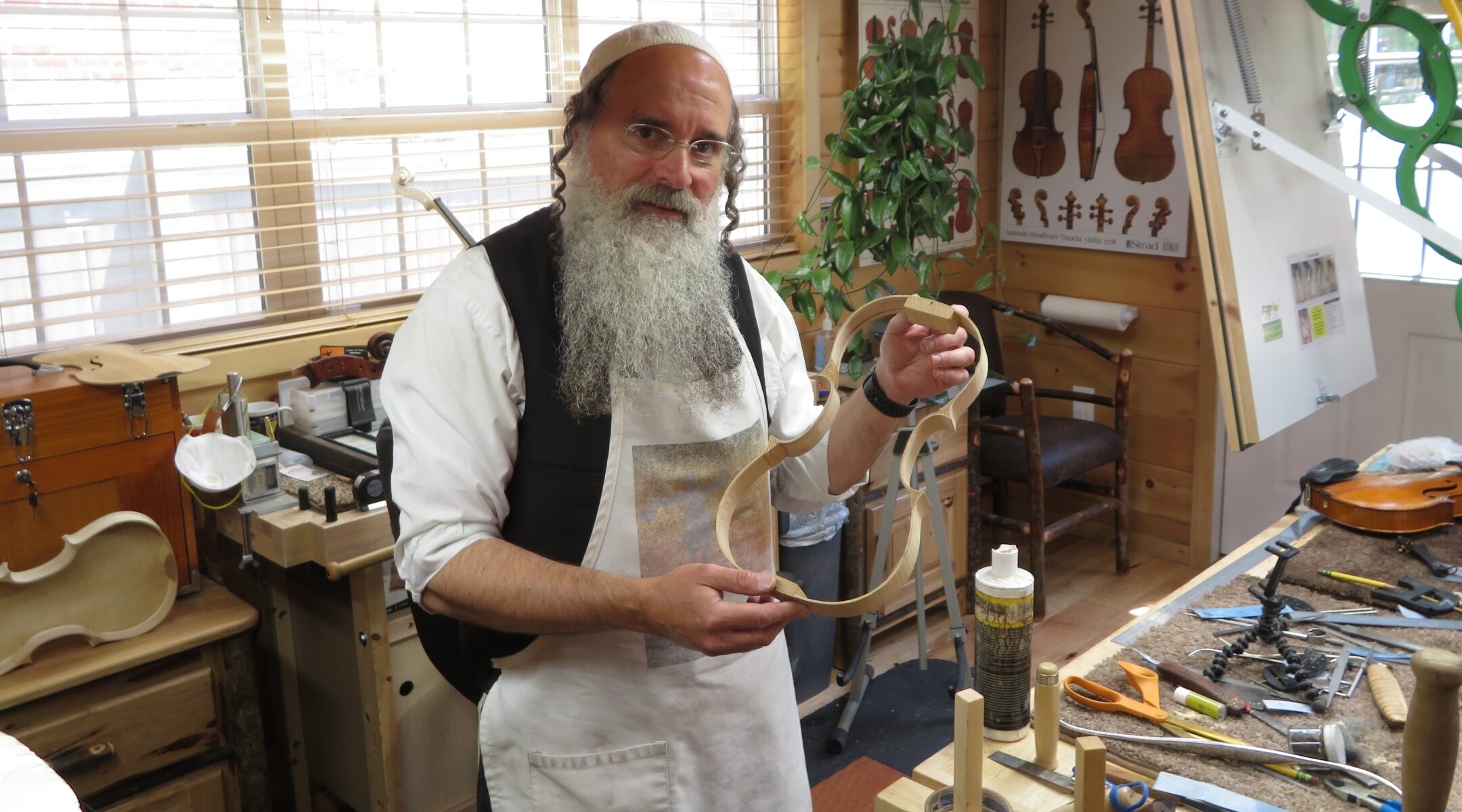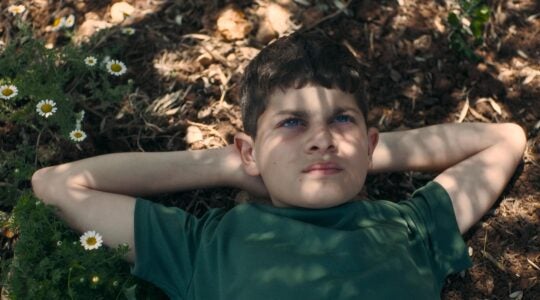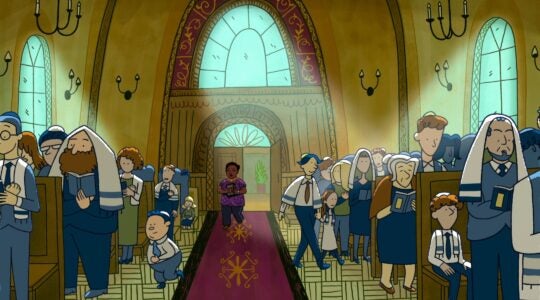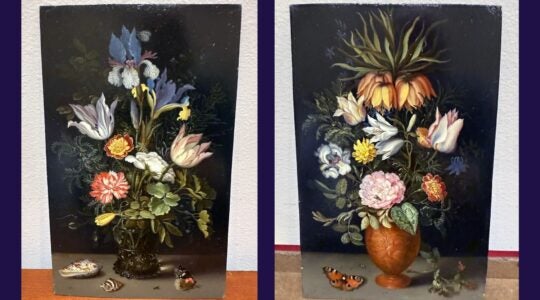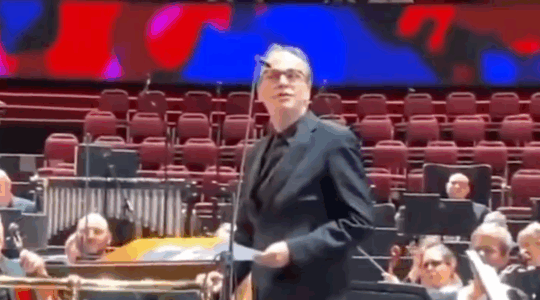SILVER SPRING, Maryland (JTA) — The Star of David pendant comes exactly 15 minutes into the 16.5-minute documentary.
It bounces against the chest of a guy with big hair who’s prancing in front of his girlfriend, who has equally big hair. He’s wearing suspenders over a bare torso, and he has something to say about this moment in 1986, in a suburban Maryland parking lot, where fans of the rock band Judas Priest are waiting to get “f**ked up,” as several documentary subjects and one of the filmmakers put it.
“Let’s rock, OK, all right!” says the big-haired guy, as the Jewish symbol bounces in and out of the frame.
Thirty-five years later, that man, who was once known as Robbie Ludwick, has a different take.
“When I listen to heavy metal, I don’t see the hand of God,” says Zev Zalman Ludwick, a member of the Breslov Hasidic sect who lives a quiet life in the Maryland suburbs. Instead of pregaming in parking lots, Ludwick now mends damaged violins and tends koi fish in his backyard about a 20-minute drive from the long-demolished Capital Centre, where he saw Judas Priest perform on Memorial Day weekend in 1986.
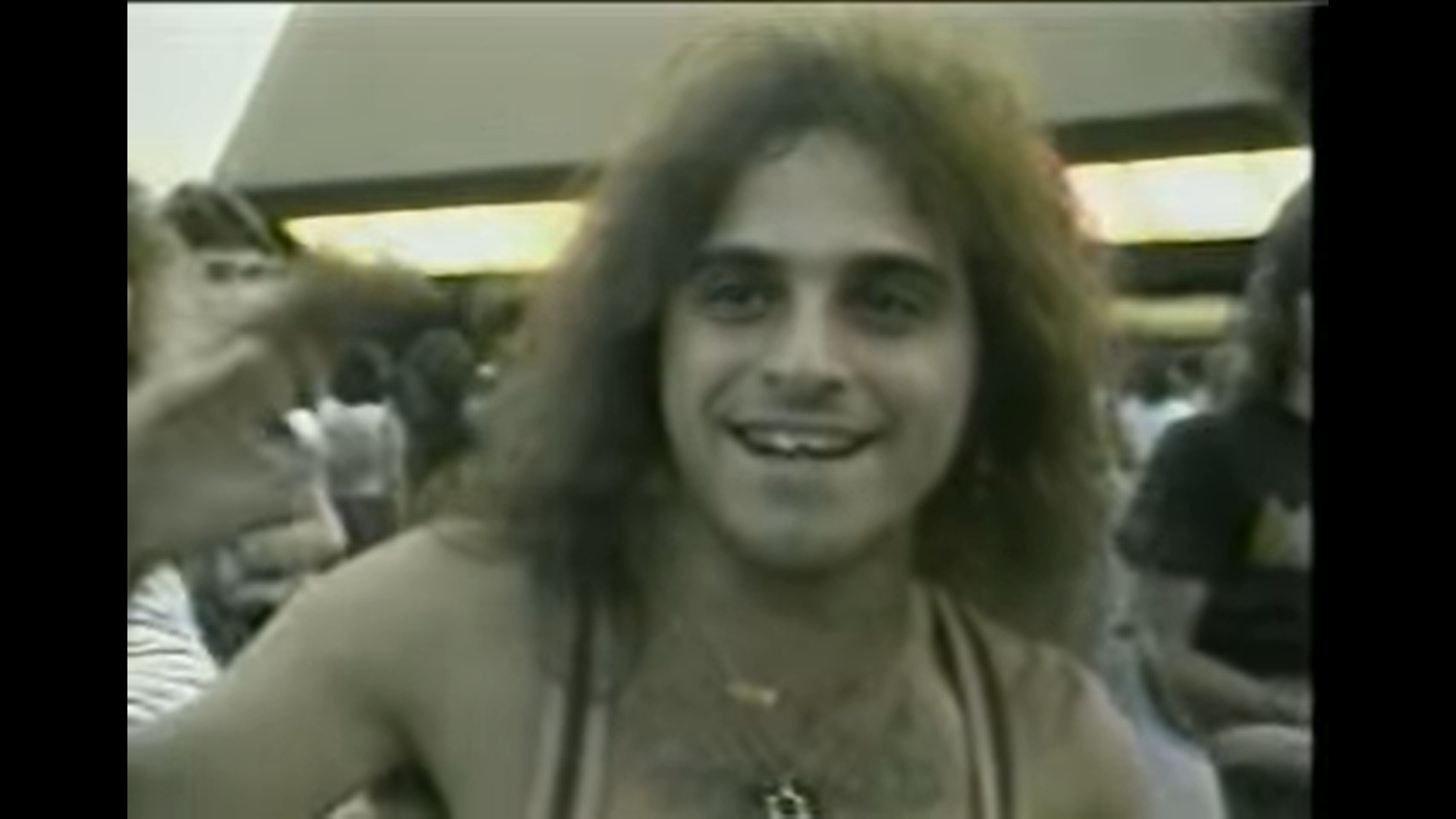
“Let’s rock!” cries out Robbie Ludwick in a screenshot from the 1986 documentary, “Heavy Metal Parking Lot.”
“Heavy Metal Parking Lot,” a mini-documentary that accidentally achieved iconic status via underground word-of-mouth, turned 35 years old this year. It has received no shortage of accolades during that time: the sports website Deadspin once called it “the ‘Citizen Kane’ Of Wasted Teenage Metalness.” Professed fans include filmmakers Sofia Coppola and John Waters, and Dave Grohl, the Foo Fighters frontman.
Today it’s held up as a snapshot of a before-time: before the Internet erased physical presence as a predicate for human interaction — a time when, if you wanted to find people who thought like you, you had to get into a car and drive out to a parking lot in a godforsaken suburb and, well, find them.
That search continues today, in a different way. Many of the documentary’s subjects, men and women in their teens and twenties in 1986, now see the film refracted through not just nostalgia but the exigencies of aging and experience. And for at least three people involved — Ludwick and the film’s two directors, John Heyn and Jeff Krulik — some of the experiences that color their viewing of the film today are Jewish.
In 1986, Krulik, then 25, worked at a public access TV station in Prince George’s County, in Maryland’s D.C. suburbs. Heyn, 28, had a job duplicating videotapes for internal company use. He heard Krulik wanted to make documentaries and had access to the necessary equipment, so he got in touch. They filmed a local group’s rock concert in-house in the studio.
They then cast around for a second idea. Heyn heard there was a Judas Priest concert at the Capital Centre in Landover, and the duo’s thoughts turned to the types of people who would be in attendance.
“Heavy metal fans were a subculture that we didn’t really know firsthand, but we were curious about,” Krulik said.
“We were more into punk and new wave,” Heyn said. Krulik and Heyn had become fast friends, with much in common: namely, a suburban Jewish Maryland upbringing. “A lot of it’s just kind of an unspoken bond,” said Krulik. “Being Jewish is one way we bonded.”
But the bonding came mostly through the making of a film that Krulik likened to anthropological research. “We had a hunch that it would be entertaining and lively,” he said. “We just went into it like on some kind of an expedition.”
They loaded the car with the necessary equipment and rolled out on a bright May afternoon. The film starts with the two-man crew pulling into the parking lot. They pay the attendant, and then, to the soundtrack of Judas Priest’s “You’ve Got Another Thing Coming,” they roll by tailgate parties. Inchoate cheers of “Prieeeeeest!” erupt from the clusters of women, dressed to the nines, and guys, in t-shirts or more often bare-chested.
The next 16 minutes are a mix of eccentric and troubling. A shirtless man posits that “they should make a joint so big it fits across America, and everybody would smoke it”; a guy in a zebra-print pantsuit damns Madonna to hell; a 20-year-old french kisses a 13-year-old. (That moment has sparked much online disgust, and the man and the girl have since said that it was a one-off for the camera.)
“People came to us,” Heyn recalled of the shoot. “It was like swimming in the ocean, all the beautiful fish that you would see in a coral reef. The gems were there for us to take. There’s just a whole level of innocence and happiness and joy about it, and [none of the] self-consciousness that I think is really prevalent today because cameras are so ubiquitous.”
It was infectious, although it took a while to infect: Screenings in the DC area were at first pretty much limited to record conventions. Heyn and Krulik graduated to more mundane jobs until 1992, when a VHS copy of the film landed on the Nirvana tour bus. From there, celebrities including Grohl, then Nirvana’s drummer, embraced it, and the rest is history.
“This was their bread and butter,” Krulik said of the celebrities who embraced the film and who were fascinated by its close-ups of the fans they otherwise kept at a distance. “They didn’t go into the belly of the beast. Now, it’s different. Now there’s much more contact. You can’t be successful unless you have contact with your fans. Back then there was a real separation, a real line that was rarely or never crossed.”
Krulik worked for a period in the 1990s at the Discovery Channel and then branched out into short documentary films, at times reuniting with Heyn. The filmmaker continued his fascination with the fraught intersections between cultural phenomena and their consumers.
A sampling: “Ernest Borgnine on the Bus” tracks the actor who played heavies in the 1950s and 1960s as he travels the country in his later years to meet fans; “Go-Go Girls Don’t Cry: The Art of Fred Folsom” is about a devout Christian artist whose muses were strippers at a club near his home; “Led Zeppelin Played Here,” with Heyn, is about a 1969 DC-area concert by the legendary band, which a lot of people remember taking place, but for which there is no evidence; and “Harry Potter Parking Lot”, centered on a J.K. Rowling book signing in Washington DC in 1999.
Krulik’s oeuvre also takes periodic detours into Jewish content: “Neil Diamond Parking Lot,” with Heyn, and with more women, more clothes and fewer hallucinogens than “Heavy Metal Parking Lot”; “Hitler’s Hat,” about Hitler’s top hat, kept for years by a Jewish GI; and “I Created Lancelot Link,” which reunites two Jewish TV comedy writers in 1999 who created a short-lived 1970s Saturday morning TV show about chimpanzee spies who spoke with Brooklyn accents.
Then there’s “Obsessed with Jews,” a 2000 film which is eight minutes of Neil Keller, a DC accountant, going through his apartment-filling collection of Jewish pop-culture memorabilia. “I collect Jews whether they’re good or bad,” Keller explains on-camera, setting his Jewish athlete collection aside to talk about the Jewish victim and lawyers in the O.J. Simpson case.
Krulik’s forays into Jewish content are “just kind of happenstance,” he told the Jewish Telegraphic Agency. “It’s not like I’m seeking out Jewish-themed projects — but you know, I’m happy to be pursuing them. Neil [Keller]’s kind of channeling things that I was curious about because I’m still plugged into my faith.”
Heyn, who is a documentary video producer at the National Archives, has not delved as deeply into Jewish content, although he has assisted his brother, a rabbi musician in San Francisco, in making music videos.
Like Krulik, Heyn is fascinated by fans, by the intersection between the producers of entertainment and its consumers.
“Whether it’s sports or music… there’s almost a religious fervor about it,” Heyn said. “And that particular cultural or recreational event becomes almost like a religion to people. You’re part of the flock, you’re part of the tribe.”
Many of the fans featured in the film see things differently in the rearview mirror. For one, Ludwick is not proud of a rant he gave to the camera. It was profane and, he acknowledges, homophobic.
“Ian Hill, I’m a former bass player,” he says in the film, addressing the Judas Priest bassist. “You’re an inspiration of mine. Everybody else, you’re rocking. Robert Halford, I don’t know about you, but everybody else, you’re definitely dynamite.”
His reference to Halford, he says now, had to do with rumors that the lead singer was gay. (Indeed, Halford would come out a dozen or so years later.)
“As a 22-year-old, I was always, you know, macho, whatever you wanna call it, ‘rock and roll’, or not tolerant of other people’s lifestyles, you know?” Ludwick said.
That bouncy Magen David, though, has a story, and that Ludiwick is proud of.
His mother and her parents got out of Poland at the last minute, he said: They were the last to be selected to board a ship for the U.S.; the ship, returning to Poland to fetch more Jewish families, was sunk by the Nazis.
“Talk about a miracle story,” Ludwick said. “I knew this story when I was little. And so something about that story resonated with me — that, wow, I’m such a miracle being here. And I had a big Jewish identity even though I was completely secular.”
He noticed something about his fellow metalheads. “You know, you see all the rock and rollers wearing crosses. Black Sabbath, you know, other bands with a lot of musicians would wear these crosses, so I said, ‘Where’s my Jewish star?’” he said. “So I asked my parents when they went to Israel to find me a gold star. And they did.”
Ludwick himself played bass for a metal band at the time. Why heavy metal? “Being a little guy, you have little man syndrome, you know, and, and something about that bass is just so … you feel it in your chest, you know? You feel like you’re really the carrier of thunder.”
By that time, he was also deep into addictions. “By the time I was 12, I was already addicted to drugs and alcohol,” he said. Ludwick, the youngest of six children, described a “house of sorrow” haunted by the death of his oldest sibling, a girl, from lupus when she was 17.
Then, when he was 31, Ludwick lost his best friend to a blood clot. The tragedy shocked him into seeing he needed to change. He lived for a while with a brother in Hawaii, where he developed an affinity for acoustic music. When he returned to Maryland a few months later, he bought a mandolin and got into bluegrass.
He became close to bluegrass giants like Ralph Stanley and Richard Underwood, and he also became more religious after dunking himself in a freezing cold mikvah in the mystical Israeli town of Safed on the eve of his nephew’s wedding.
Back in Maryland, Ludwick got married. He and his wife gradually became Orthodox. After they had two daughters, his wife told him he needed to do something more remunerative than playing bluegrass and working part-time at a kosher pizza restaurant. He was good at woodworking and he loved mandolins, so he googled luthiers (craftspeople who work on stringed instruments) until one brought him on to learn the trade.
After a number of years (and a second marriage) Ludwick struck out on his own, contracting out as a stringed instrument repair person. More recently he has taken to building violins from scratch. His studio is in a small building he built in his backyard, and with the midday light streaming in, he attends to the array of wooden instruments on tables and slung from the walls in various stages of repair. “Ludwick’s House of Violin, where tradition never goes out of style,” his website says. Naturally, the logo is a fiddler on a roof.

Zev Zalman Ludwick feeds koi in a pond outside his luthier studio in Silver Spring, Maryland on May 23, 2021. (Ron Kampeas)
He gravitated toward Breslov because an older brother is a devotee, but also because worshipers at the synagogues he would attend told him he looked like a Breslov Hasid, who are known for their beards and joyful dancing. (He doesn’t know why. “I don’t have a long face and my beard was short.”) His brother, about a decade ago, invited him to travel to the grave of the movement’s founder, Rabbi Nahman of Breslov, in Uman, Ukraine around Rosh Hashanah, and he decided to take on the uniform, accentuated by a large white knit kippah.
He gave his Magen David, now a piece of rock-and-roll history, to one of his daughters. Breslov Hasids, he explained, eschew jewelry.
JTA has documented Jewish history in real-time for over a century. Keep our journalism strong by joining us in supporting independent, award-winning reporting.
